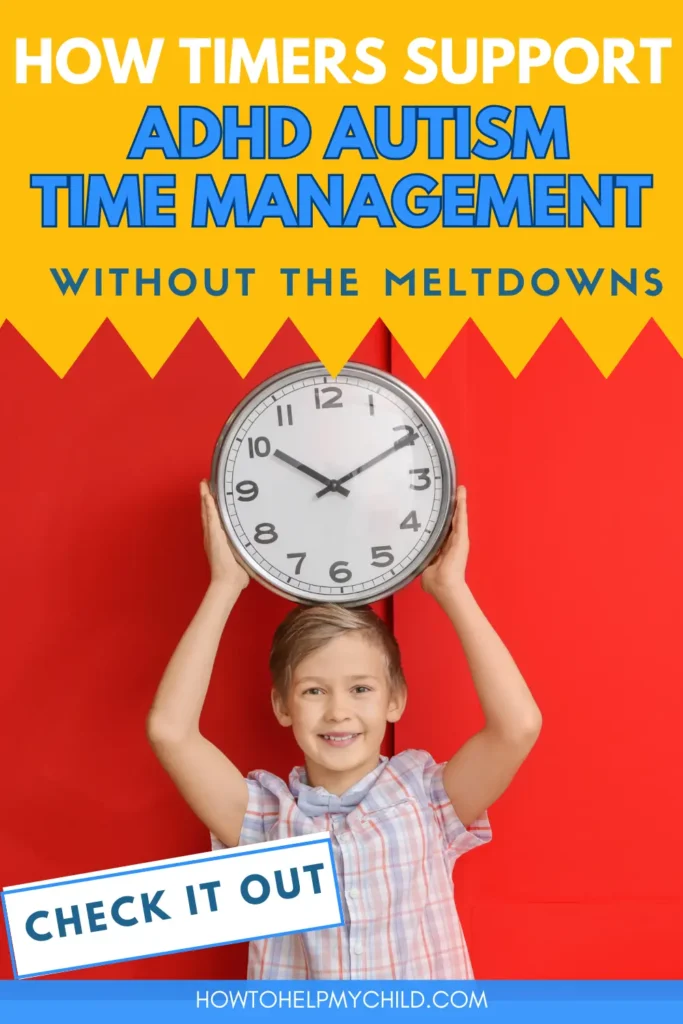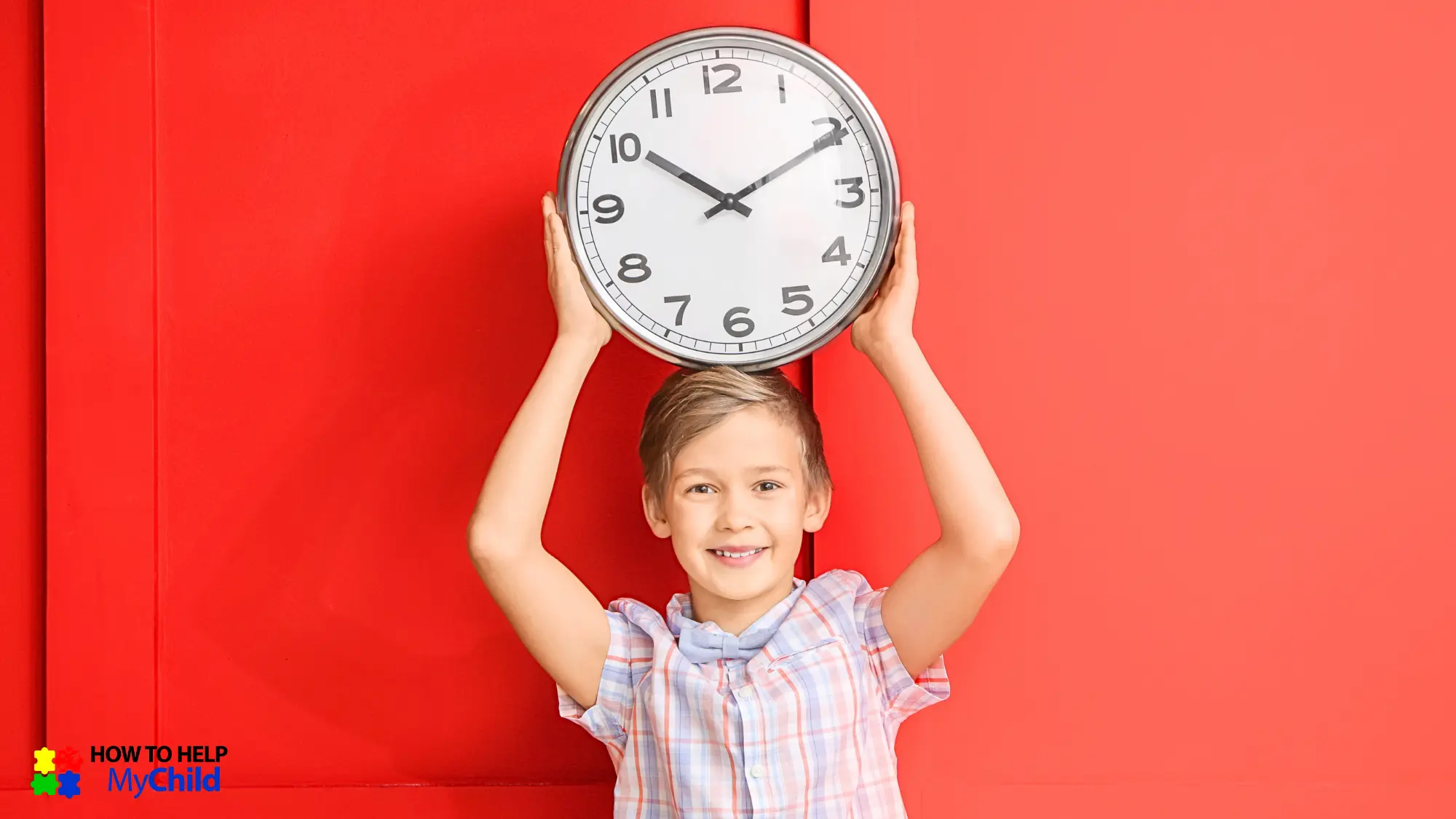ADHD Autism Time Management: 8 Steps to Help Your Child Without Meltdowns
Why Time Management Is So Hard for ADHD and Autistic Kids and What Actually Helps

Raising a neurodivergent child, you’ve likely experienced the daily chaos that comes from poor time management.
Mornings feel rushed, transitions spark meltdowns, and homework turns into a battlefield.
You find yourself constantly repeating directions, negotiating routines, or bracing for the next emotional explosion, all before lunch!
But here’s something I want you to hear clearly:
This isn’t happening because your child is lazy, defiant, or unwilling to try.
It’s because time – the way it flows, how it’s structured, how it’s felt – is neurologically different for kids with ADHD and autism.
Our children with ADHD autism time management, often struggle with time blindness, a common executive functioning challenge that makes it hard to sense how long something will take or when something is supposed to happen.
Add in anxiety, sensory sensitivities, and difficulty with transitions, and suddenly, what looks like “bad behavior” is really your child’s nervous system crying out for support.
Freebie!

Unsure if it’s a Tantrum or Meltdown?
This Guide is for YOU!
Created for moms raising kids with Autism & ADHD, this guide helps you move from confusion & stress to calm & confidence – right when BIG emotions hit. Say goodbye to second guessing & hello to REAL SUPPORT that actually helps.
Remember Mom:
When time feels predictable, their body feels safer.
When routines make sense, they’re less likely to spiral.
And when they feel empowered to take control of their day, even just a little, they begin to trust themselves. And so do you.
In this post, you’ll learn 8 strategies to improve time management for kids with ADHD or autism.
These tools aren’t about forcing your child to “hurry up.”
They’re about creating predictability,
building emotional safety,
and teaching skills that actually stick.
📺 Prefer to watch instead? Check out the video guide:
Step 1: Use Visual Schedules to Reduce Anxiety and Build Structure
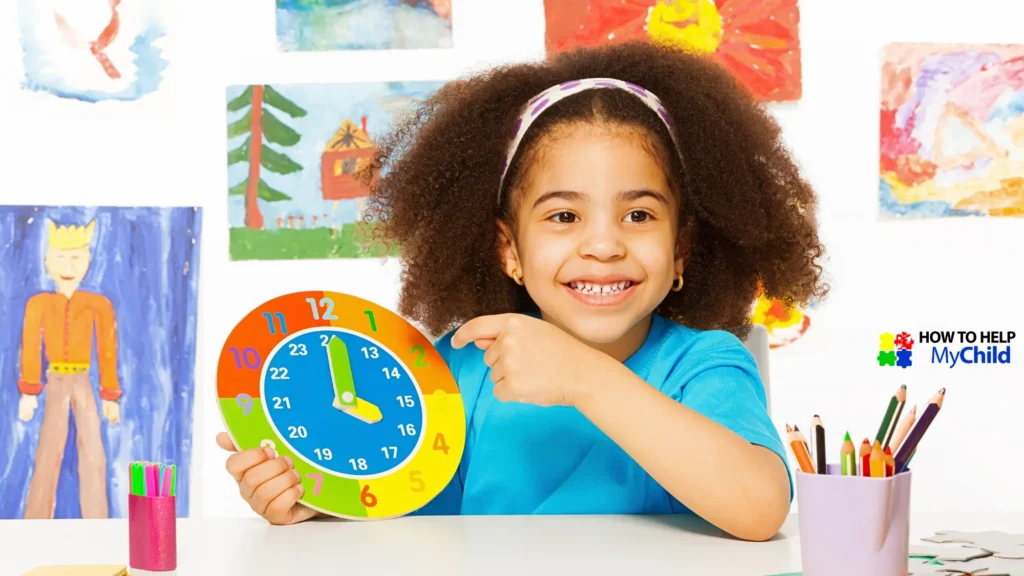
Visual schedules turn invisible time into something your child can see and relate to. That alone is a huge step that reduces their anxiety.
Our kids with ADHD and autism often struggle with working memory and transitions.
A visual schedule helps them understand what’s happening now and what’s coming next, without constant reminders from you.
Visual aids work so well because they reduce surprise.
Now we all know that element of surprise is often the biggest trigger for meltdowns.
Visual Schedules help your child feel safe and more in control of their day.
They also support independence because your child doesn’t have to rely on being told what to do 10 times. Instead they can follow along themselves and feel a sense of pride and achievement.
How to build a Visual Schedule:
- Use photos, icons, or simple words.
- Post it in a visible spot.
- Add a “done” column so your child can move each step when completed.
- Remember – this builds dopamine and confidence.
💛 From a Mom in Our Community:
“We started using a picture chart for mornings, and the daily tears stopped. Ned just checks the next step and moves on.”
— Linda, mom of 6 year old Ned with autism
Step 2: Use Timers to Ease Transitions and Build Time Awareness

Kids with ADHD or autism often experience time blindness.
They can’t gauge how long something will take or how much time has passed.
That’s why transitions feel so abrupt and jarring for them.
Timers give time a visual or auditory boundary.
When used consistently, timers can reduce those power struggles and build trust in your child’s daily routines.
Use timers to:
- Prepare for transitions – e.g. 5-minute warning before stopping play
- Create boundaries around screen time
- Support focus for tasks like homework or chores
Try this:
Use a visual timer that shows time disappearing.
Say, “You have 15 minutes for homework, then a 5-minute break.”
This helps your child see time instead of just hearing it.
Avoiding timer tantrums:
Give advance warnings like “5 more minutes”. Then try to pair the end of the timer with something calming that your kiddo enjoys like a snack or movement break. Don’t forget to celebrate when they transition successfully.
💡TIP
Try pairing a visual timer with a calming phrase like, “When the red runs out, we’re done.” This gives your child a predictable end point they can see and hear. Over time, this builds internal time awareness and reduces the panic that often comes with transitions.
Step 3: Break Down Tasks to Make Them Feel Achievable
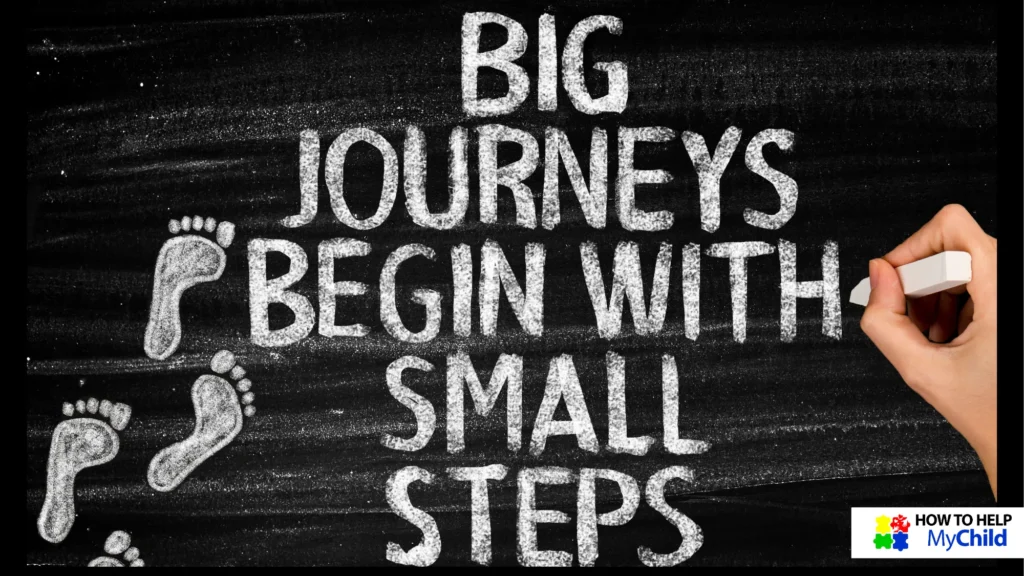
Executive functioning challenges make multi step tasks feel overwhelming for our neurodiverse children.
“Clean your room” might feel impossible to a child who doesn’t know where to start.
It is such a HUGE chore for them even to process where to start.
By breaking down tasks into smaller, manageable steps makes them less overwhelming for children with ADHD and autism.
When faced with a large, daunting task, kids often feel paralyzed and unsure where to start.
When we chunk tasks into smaller steps, we help our kids to create a sense of accomplishment and build momentum which promotes independence and a sense of success.
💡TIP
Breaking tasks into bite-sized steps reduces overwhelm and builds momentum.
How to Break Down Tasks
Assign Time: Estimate how long each step will take.
Getting ready for school example:
Identify the Task: Clearly define the task that needs to be completed.
List the Steps: Break the task down into smaller, actionable steps.
Sequence the Steps: Put the steps in a logical order.
Getting Ready for School: example
- Get dressed
- Brush teeth
- Eat breakfast
- Pack bag
- Put on shoes
Breaking tasks into smaller steps works because each step feels doable, which lowers overwhelm right from the start.
When your child completes a step, their brain gets a little boost of dopamine which helps them feel successful and confident.
Remember that starting is often the hardest part for kids with ADHD or autism, so these tiny wins build momentum.
For younger children, try using visual checklists they can physically tick off.
Every checkmark becomes a celebration and a step closer to independence.
💡TIP
Time management is more than a life skill for our kids.
It’s a nervous system support tool.
Step 4: Calendars and Planners to Help Kids See the Bigger Picture

Calendars aren’t just for adults.They’re a powerful way to help your neurodivergent child feel more in control of their day.
For our kids with autism or ADHD, seeing their week mapped out visually can ease anxiety, reduce surprises, and support better time management.
It also builds their planning and organization skills, which makes everything from schoolwork to after school activities a little smoother.
Choosing a Planner That Actually Works
There’s no one size fits all.
What matters most is picking something that matches your child’s age and learning style:
- Paper planners are great for younger kids. Add stickers or drawings for fun and clarity.
- Digital calendars with reminders and alarms can be super helpful for older kids or teens, especially if they’re already using a tablet or phone for school.
If your child is a visual learner, look for planners with big boxes, space for doodles, or color-coding.
How to Use a Planner to Build Calm, Not Chaos
Use the calendar to track things like:
- Homework
- Appointments
- Therapies
- Sports or hobbies
- Fun plans like Friday movie night!
Sit down regularly and go through the week together.
Add new events as they come up and let your child add their own plans, even if it’s just “play with LEGO” or “draw.”
Remember – you’re not just teaching time management.
You’re giving your child a way to see their world, prepare for it, and feel safe within it.
💡TIP
Each morning over breakfast review the calendar and make it part of the daily rhythm. It’s a great way to reduce surprises, support emotional regulation, and help your child start their day feeling calmer and more in control.
Step 5: Build in Breaks to Prevent Burnout
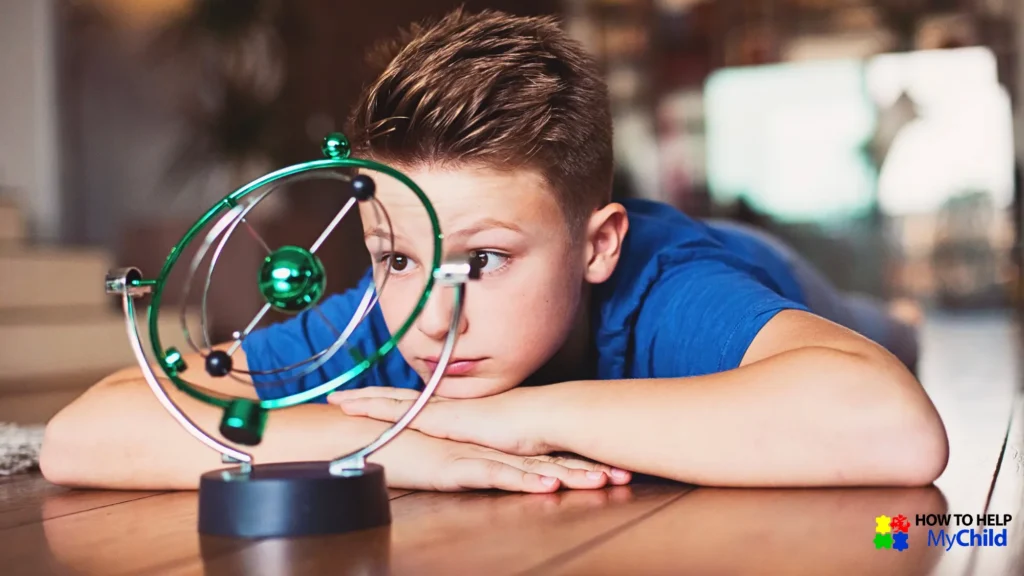
Kids with ADHD or autism can become overwhelmed quickly, especially if they’re masking or holding it together all day at school.
You know what that looks like, Mom!
Regular breaks will help them reset before they reach boiling point.
Preventing Burnout
Taking regular breaks helps your child with autism and ADHD prevent burnout and improves their focus.
When children are constantly working without breaks, they become fatigued and their attention struggles.
It is important to teach our children how to recognize their own limits and that it is ok to take a break. Infact, it is essential.
When our kids are hyper focused they may not recognize they need a break.
Types of breaks that help:
- Movement break – jumping jacks, trampoline, walk outside
- Sensory break – fidgets, playdough, weighted blanket
- Calm break – music, art, reading
- Food break – protein-rich snack, crunchy foods, hydration
- Brain break – short game, doodling, 5-minute timer for free play
💛 From a Mom in Our Community:
“At first, I felt guilty scheduling so many breaks into Liam’s afternoon, like I was giving up on his productivity. But once I saw how those breaks actually prevented meltdowns, everything changed. Now we build them in before he gets overwhelmed, and our afternoons feel so much calmer.”
— Jen, mum to Liam, 11 ADHD + sensory needs
Teach body awareness:
Help your child learn to be aware of when they are getting frustrated or overwhelmed.
Teach your autistic or ADHD child to recognize their signs of stress such as – fast breathing, clenched fists, restlessness, increased heart rate, muscle tension, or irritability.
Then encourage them to take a break before a meltdown happens.
Knowing when to take a break is an important self-regulation skill.
Learning to self regulate is such an important life skill.
While they are learning to do this, schedule breaks into their day.

You’re Not Alone – Find Your Support System Here!
Parenting a child with autism or ADHD can feel isolating—endless meltdowns, sleepless nights, & feeling like no one understands But you don’t have to do this alone.
❣️Get real-life strategies to handle daily challenges.
❣️Connect with moms who get it—no judgment, just support.
❣️Share your wins (and struggles)
❣️Find encouragement, advice, & a place to vent when you need it most.
👉Join our private Facebook group today and step into a community that truly understands!
Step 6: Reinforce Success With Rewards and Positive Feedback
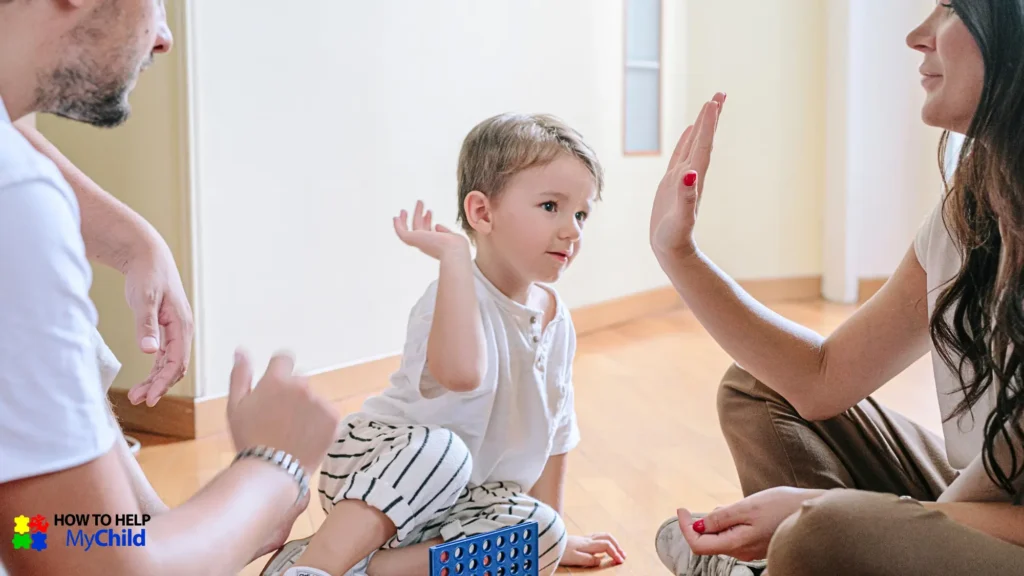
ADHD brains crave dopamine.
They thrive on encouragement, feedback, and success.
That’s why rewards are more than just bribes – they’re brain-based support.
The Power of Positive Feedback
Rewarding children for completing tasks and sticking to their schedule increases motivation and improves behavior.
Positive feedback reinforces desired behaviors and creates a positive association with time management.
Focus on the effort and progress that your child attempts, not just their results.
💡TIP
Focus on the effort and progress that your child attempts, not just their results.
Reward what you want to see more of:
- “You stuck to your schedule today — awesome focus!”
- “You paused and took a break when you felt frustrated — that’s growth!”
Types of rewards:
- Praise and high fives – don’t underestimate these!
- Token systems – stickers, marbles, checkmarks
- Privileges – extra screen time, choice of dinner
Incorporate intrinsic rewards (like a sense of accomplishment) into your reward system.
Whilst extrinsic rewards (like tangible items) can be effective, it is intrinsic motivation that will become more sustainable in the long run.
Over time, shift the focus from external rewards to internal ones like pride, calm, independence.
Help your child find satisfaction in completing tasks and managing their time effectively.
Step 7: Teach Prioritization – Even in Small Doses

Understanding Importance and Urgency
Understanding the concepts of importance and urgency are so important to help your neurodiverse child learn about prioritization.
Important tasks are those that contribute to long term goals.
While urgent tasks require immediate attention.
You can role play scenes to help teaching differentiation between important and urgent tasks.
How to teach prioritization:
- Use language like “first, then” and “important vs. urgent”
- Model prioritization out loud: “Homework is due tomorrow, so that comes first. Laundry can wait.”
- Use visuals like color coding or numbering tasks
Remember Mom – this skill takes time.
Lots of practice is required to grasp this skill.
Celebrate any attempt to think ahead – even if it’s just choosing which toy to clean up first.
Be aware that many of our neurodivergent kids see all tasks as equally urgent and this leads to decision fatigue and shutdown.
Step 8: Handling Resistance, Setbacks, and Staying Consistent – Without Losing Your Mind!

Even with the best strategies in place, there will be moments when your child resists, things fall apart, or nothing seems to work.
That doesn’t mean you’re doing anything wrong Mom.
It just means your child is human.
And they are still learning.
Dealing with Resistance
If your child pushes back against timers, checklists, or routines – start by involving them in the process.
Ask them what they think would help.
Offer choices where you can: “Do you want to use the red timer or the blue one?” or “Should we do this before snack or after?”
When kids feel like they have a little control, they’re way more likely to get on board.
Handling Setbacks with Grace
Some days will be harder than others.
Your child might forget the plan, resist the routine, or completely melt down.
That’s okay.
Instead of jumping to “What went wrong?”
try, “What can we learn from this?”
Let your child know that mistakes are part of learning and that you’ll always help them get back on track.
Staying Consistent – Even When It’s Tough
The real magic of time management isn’t in the perfect planner or the fanciest timer – it’s in the consistency.
Routines help your child feel safe.
Predictability reduces anxiety.
So even when it feels repetitive or exhausting, stick with it.
Every time you follow through on a routine or reset after a tough moment, you’re helping wire your child’s brain for resilience and success.
The best time management tools in the world won’t work if they’re used inconsistently.
Your neurodivergent kids need repetition, predictability, and safe feedback loops to learn.
Even if it feels like nothing is sticking, I assure you – it is.
Every routine repeated,
every timer set,
every checklist used,
is wiring your child’s brain for success.
Keep going.
Encourage effort.
Model calm.
And remember: your connection matters more than perfection.
You can do this!
Take care,
Sue
🍃💖🍃

Love to pin? Share the love on Pinterest …

